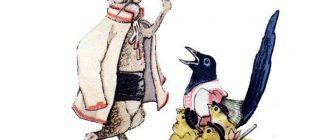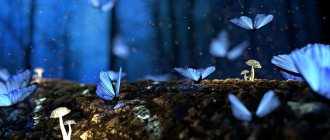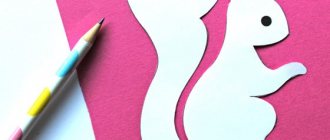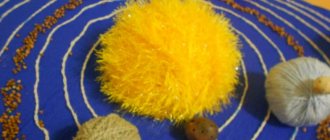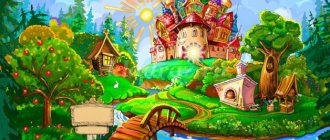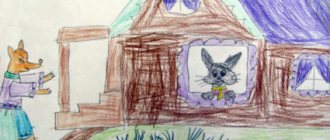Nazilya Khismatullina
Thematic applique with drawing elements “Visiting the Sun”
TASKS:
— Teach children to draw simple plots based on fairy tales.
— Reinforce the technique of cutting round shapes from squares of different sizes.
— To lead to an understanding of the generalized way of depicting different animals (chicken and duckling)
in applique and drawing - based on two circles or ovals of different sizes
(torso and head)
.
— Develop a sense of color, shape and composition.
— Foster independence, confidence, initiative.
MATERIALS, TOOLS, EQUIPMENT:
Sheets of white and blue paper for the background, yellow or orange paper squares of different sizes: the largest for the sun, medium-sized for the body of a duckling and chicken, the smallest for the head (thus, each child should have a set of one large , two medium and two small squares); scissors, glue, glue brushes, colored pencils and markers, paper and cloth napkins. Two or three versions of the composition “ Visiting the Sun ”
for showing to children.
MAGAZINE Preschooler.RF
Compiled by the teacher of the first qualification category of the preschool department of State Budget Educational Institution Secondary School No. 937 named after the Hero of Russia A. Perov O.A. Makueva.Goal: To evoke a positive emotional attitude in children; develop imagination and creativity in the process of acting out a fairy tale and conveying an image in drawing. Objectives of educational areas: Socialization: promote the unification of children in joint activities; form friendly relationships; Develop emotional responsiveness; Cultivate interest in forms of folklore; Communication: Learn to convey the characteristic features of fairy tale characters using facial expressions and gestures; practice children in pronouncing nursery rhymes with different intonations; Enrich your vocabulary. Cognition: Introduce children to a new fairy tale; To provide knowledge about the unique nature of the middle zone; Foster an interest in nature; Reading fiction: Introduce children to verbal art; Form a holistic picture of the world through artistic expression. Music Develop a sense of rhythm; Develop emotional responsiveness through movement. Artistic creativity: Learn to convey your impressions in free independent visual activity. Integration of educational areas: Socialization, communication, cognition, reading fiction, artistic creativity, music. Materials for the lesson: chicken hats, bi-ba-bo dolls, homemade toys: the sun and the cloud, tinted sheets of A4 paper, brushes, gouache paints, colored paper for the image of the sun, glue, rags, oilcloths. Preliminary work: looking at illustrations for the fairy tale “The Sun is Visiting”, memorizing nursery rhymes, looking at illustrations for nursery rhymes; games with bee-ba-bo dolls. Progress of the lesson: The teacher greets the children with the words: “Hush, children, come on in, Don’t frighten off our fairy tale... The fairy tale has already come to us, It is waiting for our children... And in our fairy tale there lives a crested hen with chicks.” The teacher shows a chicken (bi-ba-bo toy) and invites the children to become little chickens. The teacher reads a nursery rhyme, the children act it out: “The chicken went out for a walk, to nibble some fresh grass. And behind her are the boys, yellow chickens. Ko-ko-ko, ko-ko-ko, don’t go far, row with your paws, look for grains.” The teacher invites the children to go to the fairy tale “Visiting the Sun.” The teacher begins to tell a fairy tale: “Suddenly a large cloud covered the sky. The red sun set behind the dark forests. In the forest, the birds fell silent, everyone sat down in their places. Everyone sat down in their places, among the willow bushes. The sun didn't show for three days. The chickens are bored without him. And they decided to go look for the sun and return it to the blue sky. (The teacher invites the children, in the role of chickens, to go on a journey through a fairy tale.) They walked and walked, and suddenly they saw a snail sitting behind a head of cabbage. The chickens stopped and said: Children-chickens: “Snail, snail, stick out your horns, We will give you cakes and pork legs... Please tell us, where did the sun go?” Snail: “No, I don’t know. There's a magpie sitting there. Maybe she knows? Chicken children: “Magpie - magpie, magpie - white-sided, Where have you been, how far away? Have you seen the sun? Magpie (doll-bee-ba-bo): I haven’t seen it, but I’ll go with you to look for the sun. Let's ask the hare, he lives next door. Maybe he knows where the sun went. The teacher invites one of the children to put a magpie on his hand. The hare saw that guests were coming to him, and opened the gate wider. Chicken children: Hare, hare, where did you run? Into the oak forest, what were you doing there? Don't you know, hare, where the sun went? We're looking for him. Hare (doll - bee-ba-bo): I don’t know, but my neighbor the duck probably knows; she lives by the stream, in the reeds. And the hare led everyone to the stream. (One of the children puts a toy hare on his hand.) Chicken children: “Duck, duck, honk.” Hey duck, are you home or not? Duck (doll-bee-ba-bo): Home, home! I still can’t dry out; there was no sun for three days. Chicken children: And we are just going to look for the sun! Don't you know where it lives? Duck: I don’t know, but behind the stream, under a hollow beech tree, a hedgehog lives, he probably knows, let’s go ask him (one of the children puts a duck toy on his hand). They crossed the stream in a canoe and went to look for the hedgehog. And the hedgehog sat under the beech tree and dozed. Chicken children: Hedgehog, hedgehog, sharp needle, Don’t prick our finger, but tell me, do you know where the sun lives? The hedgehog thought and said: Hedgehog-doll be-ba-bo: How can you not know! I know where the sun lives. There is a big mountain behind the beech tree. There is a big cloud on the mountain. There is a silver moon above the cloud, and there the sun is just a stone's throw away! The hedgehog took a stick, pulled his hat down and walked ahead of everyone to show the way. (One of the children puts a hedgehog toy on his hand.) So they came to the top of a high mountain. And there the cloud clings to the top and lies there. Children: “Cloud, cloud! Come down lower! Come down lower and take us to the bell-shaped sun!” A chicken, a magpie, a hare, a duck and a hedgehog climbed onto the cloud, sat down, and the cloud flew straight to visit the month. (Children sit on the carpet). Educator: “A clear month rolled across the azure sky. He threw bright clouds onto the fast, deep rivers.” The moon saw the guests and quickly lit up its silver horn. Children: Month, month, show us where the sun lives? He was not in heaven for three days, we missed him. The month brought them straight to the gates of the Solntsev house, and there it was dark, there was no light: the sun had fallen asleep. Then the magpie chattered, the chickens squealed, the hare flapped its ears, the duck quacked, the hedgehog knocked with a stick: Children: “Sunny, look out! Flash the red! On the cold water, on the silken grass, on the scarlet flower, on the round meadow.” We came to wake you up, the morning has come. Sun (toy): I can’t look at the sky. For three days the clouds hid me, for three days they obscured me, and now I can’t even shine... The hare heard about this - he grabbed a bucket and let’s carry water. The duck heard - let's wash the sun with water. And wipe the forty with a towel. Let's clean the hedgehog with prickly bristles. The sun came out into the sky, clean, clear and golden. And everywhere it became light and warm. The chicken also came out to bask in the sun. She clucked and called the chickens to her. And the chickens are right there. They run around the yard, look for grains, and bask in the sun. Whoever doesn’t believe it, let him look: are chickens running around the yard or not?” At the end of the lesson, the teacher encourages the children for their artistry, diligence, expressiveness in conveying images and offers to do the work and portray themselves in the image of a fairy tale hero on a hike to find the sun.
| Next > |
Thematic applique with drawing elements “Visiting the Sun”
(average age)
Program content.
Teach children to draw simple stories based on fairy tales. Practice the technique of cutting round shapes from squares of different sizes. Foster independence, confidence, initiative.
Preliminary work.
Reading the fairy tale “Visiting the Sun”, conversation on the content. Looking at illustrations in children's books. Conversation about the sun. Mastering the technique of cutting round shapes from squares by rounding the corners.
Materials, tools, equipment
Sheets of white and blue paper for the background, yellow or orange paper squares of different sizes: the largest for the sun, medium in size for the body of a duckling and chicken, the smallest for the head (thus, each child should have a set of one large, two medium and two small squares); scissors, glue, glue brushes, colored pencils and markers, paper and cloth napkins.
Two or three versions of the composition “Visiting the Sun” for showing to children.
Contents of the lesson.
The teacher reads to the children an excerpt from the fairy tale “Visiting the Sun”:
One day a large cloud covered the sky. The sun didn't show for three days. The chickens are bored without sunlight.
-Where did that sun go? - They say. “We need to return him to heaven as soon as possible.”
-Where will you find him? - the hen cackled. - Do you know where it lives?
“We don’t know, but we’ll ask whoever we meet,” answered the chickens.
The hen collected them for the journey. She gave me a bag and a purse. In the bag there is a grain, in the purse there is a poppy seed.
The chickens have left. They walked and walked and saw: in the garden, behind a head of cabbage, a snail was sitting. She is big, horned, and has a hut on her back.
The chickens stopped and asked:
- Snail, snail, do you know where the sun lives?
- Don't know. There's a magpie sitting on the fence - maybe she knows.
“And the magpie didn’t wait for the chickens to come to her.” She flew up to them, chattered, and crackled:
- Chickens, chickens, where are you going? Where are you going? Where?
The chickens answer:
- Yes, the sun has disappeared. He was not in heaven for three days. Let's go look for him.
- And I will go with you! And I will go with you! And I will go with you!
- Do you know where the sun lives?
“I don’t know, but the hare maybe knows: he lives next door, across the border!” - the magpie chattered...
Then the magpie chattered, the chickens squeaked, the duck quacked, the hare flapped his ears, and the hedgehog tapped with his stick:
- Red bucket sun, look out, shine it!
- Who is screaming under the window? - asked the sun. - Who is stopping me from sleeping?
- It’s us - chickens, a magpie, a hare, a duck, and a hedgehog. We came to wake you up: morning has come!
The teacher invites the children to make appliqué pictures about how the chicken and duckling woke up the sun. Shows options for a plot composition (“The sun and a chicken with a duckling”) and paper blanks - yellow or orange squares of different sizes. He asks what size squares are best to cut out a sun and a chicken and duckling. Alternately shows large, medium and small squares. Children guess that they need to cut out the sun from the large one, the torso from the medium-sized ones, and the head from the small ones. The teacher clarifies the children's understanding of the technique of cutting a circle from a square by rounding the corners. It is advisable to first cut out the largest circle for the sun and glue it at the top of the sheet, and then cut out and glue the chickens. First he shows an unfinished applique - a composition of 5 circles: at the top in the center is the largest circle-sun, below on the sides are the silhouettes of a chicken and a duckling (circle-torso + circle-head). Then he demonstrates the completed compositions and advises you to complete the details according to your ideas: for a chicken with a duckling - beaks, eyes, wings, tails, for the sun - rays and a face.
- Now guys, stand up! They quickly raised their hands up, to the sides, forward, back, turned to the right, left, sat down quietly, and got back to work.
Children choose paper for the background and begin to create their appliqué paintings.
